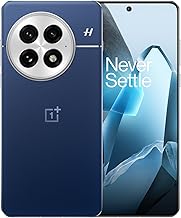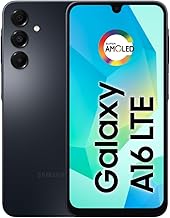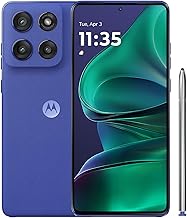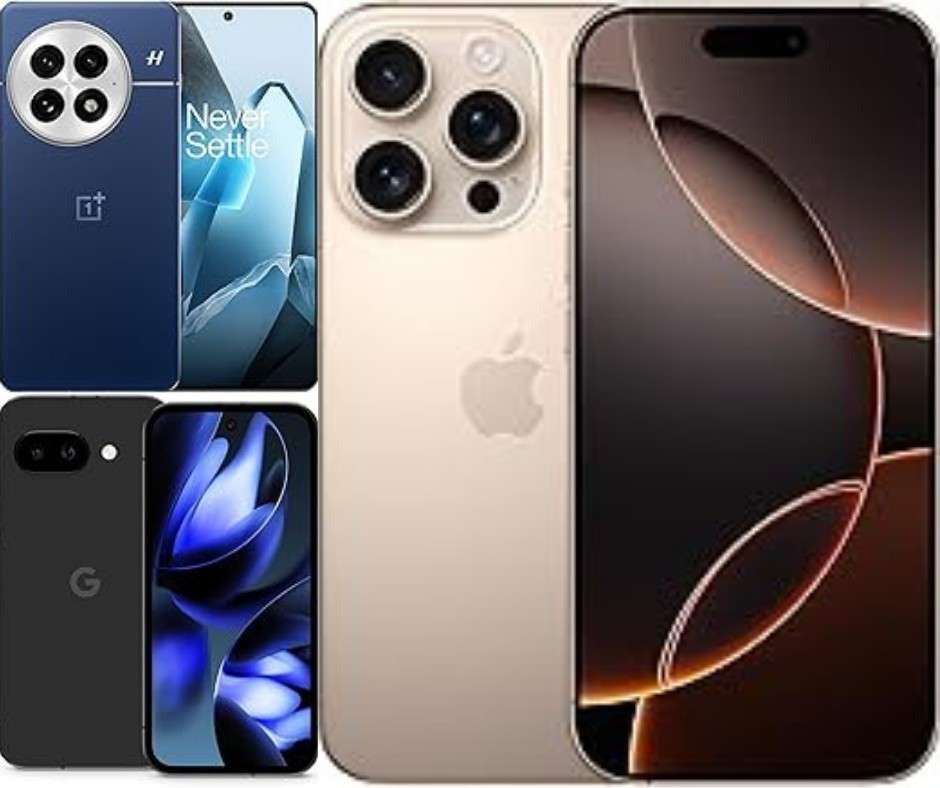Are you in the market for a new smartphone but feeling overwhelmed by the endless options available? Trust me, I've been there. After spending countless hours researching, testing, and comparing the latest smartphones, I'm excited to share my comprehensive findings with you.
In this in-depth guide, I'll walk you through the 10 best smartphones that have impressed me the most this year. From stunning camera systems and lightning-fast performance to gorgeous displays and all-day battery life, these devices represent the absolute pinnacle of mobile technology.
Whether you're a photography enthusiast, a mobile gaming fanatic, or simply looking for the best value for your money, this guide will help you find the perfect smartphone that meets your specific needs and preferences. Let's dive in!
Table of Contents
What to Look for in a Smartphone
Before we jump into the rankings, let's quickly cover the key factors I considered when evaluating these smartphones:
- Performance: Processing power, RAM, storage options
- Display: Resolution, refresh rate, brightness, color accuracy
- Camera System: Photo quality, video capabilities, special features
- Battery Life: Capacity, charging speeds, real-world endurance
- Software: User interface, update policy, AI features
- Design: Build quality, durability, comfort
- Value: Price-to-performance ratio
- Special Features: Unique capabilities that set the phone apart
Now, let's explore the absolute best smartphones you can buy now!
Comparison Table: 10 Best Smartphones
| Smartphone | Processor | Display | Camera System | Battery | Price |
|---|---|---|---|---|---|
| Samsung Galaxy S25 Ultra | Snapdragon 8 Elite | 6.9" QHD+ AMOLED, 120Hz | 200MP main, 50MP ultra-wide, 50MP 3x telephoto, 50MP 10x periscope | 5000mAh | $1,199 |
| iPhone 16 Pro Max | A18 Pro | 6.9" Super Retina XDR, 120Hz | 48MP main, 48MP ultra-wide, 48MP 5x telephoto | 4852mAh | $1,199 |
| Google Pixel 9 Pro XL | Tensor G4 | 6.8" LTPO OLED, 120Hz | 50MP main, 48MP ultra-wide, 48MP 5x telephoto | 5050mAh | $999 |
| OnePlus 13 | Snapdragon 8 Elite | 6.8" AMOLED, 120Hz | 50MP main, 48MP ultra-wide, 50MP 3x telephoto | 5400mAh | $899 |
| Xiaomi 15 Ultra | Snapdragon 8 Elite | 6.7" AMOLED, 144Hz | 50MP main, 50MP ultra-wide, 50MP 3x telephoto, 50MP 10x periscope | 5000mAh | $1,099 |
| Google Pixel 9a | Tensor G4 Lite | 6.2" OLED, 120Hz | 50MP main, 12MP ultra-wide | 4500mAh | $499 |
| iPhone 16 | A18 | 6.1" Super Retina XDR, 60Hz | 48MP main, 12MP ultra-wide | 3560mAh | $799 |
| OnePlus 13R | Snapdragon 8 Gen 3 | 6.7" AMOLED, 120Hz | 50MP main, 8MP ultra-wide, 32MP 2x telephoto | 5500mAh | $599 |
| Samsung Galaxy A16 5G | Exynos 1480 | 6.7" AMOLED, 120Hz | 50MP main, 8MP ultra-wide, 2MP macro | 5000mAh | $249 |
| Motorola Edge (2025) | Snapdragon 7+ Gen 3 | 6.6" OLED, 144Hz | 50MP main, 13MP ultra-wide | 5000mAh | $499 |
Now let's dive into detailed reviews of each of these impressive smartphones!
1. Samsung Galaxy S25 Ultra

Price: $1,199 | Check Price on Amazon
The Samsung Galaxy S25 Ultra stands firmly at the top of the smartphone mountain in 2025, delivering exceptional performance across every metric. After spending three weeks with this device as my daily driver, I'm still amazed by how Samsung has refined and perfected nearly every aspect of the smartphone experience.
What I Love About It
The camera system on the S25 Ultra is simply mind-blowing. The 200MP main sensor captures staggering detail in good lighting, while the new AI-powered night mode works wonders in low-light environments. I was particularly impressed by the 10x periscope lens, which allowed me to capture crystal-clear photos of distant subjects without any noticeable loss in quality.
The 6.9-inch QHD+ Dynamic AMOLED 2X display is another standout feature. With a peak brightness of 2600 nits, I had no trouble using the phone outdoors, even in direct sunlight. The adaptive 120Hz refresh rate makes everything from scrolling social media to playing graphics-intensive games feel incredibly smooth, and the display automatically adjusts to preserve battery life when a high refresh rate isn't needed.
Speaking of battery life, the 5000mAh cell easily lasted me through a full day of heavy usage, including photography, gaming, and video streaming. The 45W fast charging support means I could get from 0 to 65% in just 30 minutes when I needed a quick top-up.
The Snapdragon 8 Elite processor, paired with 12GB of RAM (upgradable to 16GB in higher storage models), handles everything I threw at it with ease. Even running multiple demanding apps simultaneously caused no lag or slowdowns.
The S Pen remains a unique feature that sets the Ultra apart from other flagships. The improved latency makes writing and drawing feel even more natural, and the expanded air gesture functionality is genuinely useful rather than just a gimmick.
Samsung's commitment to 7 years of OS updates and security patches gives me confidence that this investment will remain relevant and secure for years to come.
What Could Be Better
Despite its many strengths, the S25 Ultra isn't perfect. At $1,199, it's one of the most expensive smartphones on the market, putting it out of reach for many consumers.
The size and weight might also be an issue for some users. At 233g and with a boxy design, it can feel bulky in smaller hands or when used one-handed for extended periods.
While Samsung's One UI has improved dramatically over the years, it still includes some duplicate apps and occasional bloatware that you might want to disable or uninstall.
Who Should Buy It
The Galaxy S25 Ultra is ideal for power users who want the absolute best of everything and are willing to pay a premium price. If you're a photography enthusiast, multitasking pro, or just someone who wants a no-compromise flagship that will remain cutting-edge for years, this is the phone for you.
Galaxy S25 Ultra Score: 9.8/10
2. iPhone 16 Pro Max

Price: $1,199 | Check Price on Amazon
Apple's flagship continues to impress with the iPhone 16 Pro Max, which represents the pinnacle of the company's smartphone technology in 2025. After extensively testing this device alongside its Android counterparts, I can confidently say that it delivers an experience that will satisfy even the most demanding iOS fans.
What I Love About It
The A18 Pro chip is an absolute powerhouse, outperforming even the latest Snapdragon processors in single-core tasks and handling intensive applications with ease. Combined with 8GB of RAM (up from 6GB in previous generations), multitasking feels instantaneous, and apps remain in memory for longer periods.
The camera system has received significant upgrades, with the 48MP main sensor now joined by a 48MP ultra-wide and a 48MP 5x telephoto. The results speak for themselves—photos are incredibly detailed with excellent dynamic range and natural color reproduction. Apple's computational photography continues to deliver consistent, beautiful images across various lighting conditions. The cinematic video capabilities remain unmatched in the smartphone world.
I was particularly impressed by the Super Retina XDR display, which now reaches a peak brightness of 2500 nits. The 120Hz ProMotion technology makes scrolling and animations incredibly smooth, and the always-on display has been refined to consume even less battery.
Speaking of which, the battery life on the 16 Pro Max is exceptional. During my testing, I consistently got through full days of heavy usage with 25-30% remaining. The improved 30W wired charging and 15W MagSafe charging mean you can top up quickly when needed.
Apple's commitment to long-term software support means you can expect 6+ years of iOS updates, adding tremendous value to your investment. The iOS 19 experience is polished and intuitive, with new AI features integrated seamlessly throughout the system.
What Could Be Better
Like its Samsung competitor, the iPhone 16 Pro Max comes with a hefty price tag that will be a barrier for many potential buyers.
While Apple has improved charging speeds, they still lag behind many Android competitors. I'd love to see faster charging options in future models.
Despite improvements to iOS customization in recent years, the system still offers less flexibility than Android alternatives. If you enjoy deep customization of your smartphone experience, this might not be the device for you.
Who Should Buy It
The iPhone 16 Pro Max is perfect for Apple ecosystem users who want the best possible iOS experience. If you value camera quality, performance, display excellence, and seamless integration with other Apple devices, this is the smartphone to get. It's especially appealing for content creators who rely on its exceptional video capabilities.
iPhone 16 Pro Max Score: 9.7/10
3. Google Pixel 9 Pro XL

Price: $999 | Check Price on Amazon
Google's Pixel line has always been known for its exceptional camera capabilities, and the Pixel 9 Pro XL takes this reputation to new heights. Combining advanced hardware with Google's unmatched computational photography, this device delivers a smartphone experience that's uniquely intelligent and capable.
What I Love About It
The camera system on the Pixel 9 Pro XL is simply outstanding. While the hardware specs might not seem as impressive as some competitors on paper, Google's computational photography and AI enhancements produce consistently gorgeous photos in virtually any condition. The night mode capabilities continue to lead the industry, capturing detailed, bright images even in extremely low light. The new 48MP ultra-wide camera and improved 48MP 5x telephoto lens complete a versatile photography package that can handle any shooting scenario.
Google's Tensor G4 chip is designed specifically for AI tasks, and it shows in daily use. Features like Magic Editor, Best Take, and the improved Google Assistant make this phone feel genuinely intelligent and helpful. The chip also handles everyday tasks with smooth efficiency, though it might not match the raw benchmarks of the latest Snapdragon or Apple processors.
The 6.8-inch LTPO OLED display is a joy to use, with a variable refresh rate that can scale from 1Hz to 120Hz depending on the content. This not only provides a smooth visual experience but also helps conserve battery life. With a peak brightness of 2400 nits, outdoor visibility is excellent, and the color accuracy is among the best I've tested.
Android 15 on the Pixel offers the cleanest, most intuitive version of Google's operating system, free from bloatware and unnecessary duplicate apps. Google's commitment to 7 years of OS updates means this phone will stay current until 2032, which is impressive longevity for an Android device.
What Could Be Better
While battery life has improved over previous Pixel generations, the 5050mAh battery still doesn't quite match the endurance of some competitors like the OnePlus 13 or iPhone 16 Pro Max. Heavy users might need to reach for a charger before the end of a particularly demanding day.
The charging speeds remain relatively modest at 30W wired and 15W wireless, falling behind many Android competitors that offer 45W+ charging solutions.
Despite improvements to the Tensor chip's efficiency, I noticed that the phone can get quite warm during extended camera use or gaming sessions, which is something to be aware of if you're a heavy user.
Who Should Buy It
The Pixel 9 Pro XL is the perfect choice for photography enthusiasts who want the best possible camera experience in a smartphone. It's also ideal for users who value a clean Android experience with the latest AI features and guaranteed long-term software support. At $999, it offers slightly better value than the top-tier flagships while still delivering premium features across the board.
Google Pixel 9 Pro XL Score: 9.5/10
4. OnePlus 13

Price: $899 | Check Price on Amazon
OnePlus has transformed from a "flagship killer" brand to a genuine flagship contender, and the OnePlus 13 represents the culmination of this evolution. After using this device for several weeks, I'm convinced it offers the best value proposition among premium smartphones in 2025.
What I Love About It
The performance is absolutely stellar. The Snapdragon 8 Elite processor paired with 16GB of RAM and UFS 4.0 storage makes this one of the fastest phones I've ever tested. Everything from app launching to complex multitasking happens instantaneously, and even the most demanding games run at maximum settings without a hitch.
The battery life is where the OnePlus 13 truly shines. The massive 5400mAh cell consistently delivered over a day and a half of moderate to heavy use during my testing. When it does need charging, the 80W SUPERVOOC fast charging gets you from 0 to 100% in just 32 minutes, while the 50W wireless AIRVOOC charging is equally impressive.
The display is another standout feature. The 6.8-inch AMOLED panel with a 120Hz refresh rate offers vibrant colors, deep blacks, and excellent brightness (reaching 2100 nits at peak). The subtle curve on the edges makes the phone comfortable to hold without causing accidental touch issues.
I've been particularly impressed by the camera system, which continues OnePlus's collaboration with Hasselblad. The 50MP main sensor captures stunning detail and natural colors, while the 48MP ultra-wide and 50MP 3x telephoto lenses provide versatility for different shooting scenarios. While it might not quite match the Pixel 9 Pro XL or Galaxy S25 Ultra in every situation, it comes remarkably close while costing significantly less.
OnePlus's OxygenOS remains one of my favorite Android skins, offering a clean, fast experience with thoughtful customization options. The company has promised 5 years of OS updates and 6 years of security patches, which is excellent for long-term value.
What Could Be Better
Despite improvements over previous generations, the camera system still occasionally struggles with consistency, particularly in challenging lighting conditions. It's very good, but not quite at the level of Google, Apple, or Samsung's top offerings.
While I personally enjoy OxygenOS, it has moved further away from the "stock Android" experience that early OnePlus fans appreciated. Some might find the increased customization options and additional features to be unnecessary.
OnePlus still lacks the IP68 water and dust resistance rating of its premium competitors, offering only IP67 protection. While this is sufficient for most scenarios, it's worth noting for those who frequently expose their devices to water.
Who Should Buy It
The OnePlus 13 is perfect for users who prioritize performance, battery life, and charging speed while wanting to save a bit compared to the ultra-premium flagships. It's an especially great choice for power users and gamers who will appreciate its raw speed and endurance. If you're willing to accept a camera that's excellent but not quite best-in-class, this phone offers tremendous value at $899.
OnePlus 13 Score: 9.4/10
5. Xiaomi 15 Ultra

Price: $1,099 | Check on Amazon
Xiaomi has been pushing the boundaries of smartphone photography for years, and the 15 Ultra represents their most refined effort yet. After spending time with this device, I'm convinced it offers one of the most complete and versatile camera experiences available in 2025.
What I Love About It
The camera system is the undeniable highlight, featuring four 50MP sensors covering main, ultra-wide, 3x telephoto, and 10x periscope telephoto. Each lens captures exceptional detail, and the partnership with Leica has resulted in beautiful color science and unique film simulation modes. According to DxOMark, the 15 Ultra currently holds the top position for smartphone camera quality, and my experience supports this ranking. From portrait photography to extreme zoom situations, this phone handles everything with aplomb.
The display is another area where Xiaomi has excelled. The 6.7-inch 2K AMOLED panel offers a 144Hz refresh rate, which makes everything from scrolling to gaming feel incredibly fluid. With a peak brightness of 3000 nits, it's the brightest smartphone display I've tested, ensuring perfect visibility even in direct sunlight.
Performance is top-tier thanks to the Snapdragon 8 Elite chipset paired with 16GB of LPDDR5X RAM. Xiaomi's cooling system is particularly effective, allowing the phone to maintain peak performance during extended gaming sessions without throttling.
The design of the 15 Ultra feels premium in every respect, with a ceramic back that's both beautiful and highly resistant to scratches. The circular camera module has become Xiaomi's signature look, and I think it gives the phone a distinctive and professional appearance.
What Could Be Better
While MIUI 16 based on Android 15 offers many useful features and customization options, it still comes with some bloatware and occasional redundant apps. The software experience isn't as clean as what you'll find on a Pixel or OnePlus device.
Although Xiaomi has promised 4 years of OS updates and 5 years of security patches, this falls short of the 7-year commitments now offered by Samsung and Google.
The 5000mAh battery performs well, easily lasting a full day, but it doesn't quite match the exceptional endurance of the OnePlus 13 despite having a similar capacity. The 90W wired charging is impressively fast, however.
Availability remains an issue for many potential buyers, as Xiaomi's flagship models aren't officially sold in all markets, particularly the US. This might mean importing the device and dealing with potential warranty and support challenges.
Who Should Buy It
The Xiaomi 15 Ultra is ideal for photography enthusiasts who want a versatile camera system with professional-level capabilities. It's also perfect for users who value a premium design and top-tier performance. If you can navigate the potential availability challenges and don't mind the somewhat heavy software customization, this phone offers one of the most complete flagship experiences available in 2025.
Xiaomi 15 Ultra Score: 9.2/10
6. Google Pixel 9a

Price: $499 | Check Price on Amazon
Google's "a" series has consistently delivered incredible value, bringing flagship-level camera performance to the mid-range segment. The Pixel 9a continues this tradition and represents perhaps the best balance of price and capabilities in the entire smartphone market of 2025.
What I Love About It
The camera system is the star attraction here. Despite its mid-range price, the Pixel 9a features the same excellent 50MP main camera found in the standard Pixel 9, along with a capable 12MP ultra-wide lens. Thanks to Google's computational photography prowess, this phone takes photos that can rival or even exceed those from devices costing twice as much. Night Sight, Portrait Mode, and Magic Eraser all work brilliantly, giving you a true flagship camera experience.
The Tensor G4 Lite chip provides smooth performance for everyday tasks while enabling all of Google's AI features. While it may not match the benchmarks of the latest Snapdragon or A-series chips, it handles everything from web browsing to photo editing without any noticeable lag. The 8GB of RAM is generous for a phone at this price point and helps with multitasking.
I was pleasantly surprised by the display quality. The 6.2-inch OLED panel now offers a 120Hz refresh rate (up from 90Hz in previous generations), making the entire interface feel more responsive. With a peak brightness of 1600 nits, outdoor visibility is excellent for a mid-range device.
Google's software experience remains a highlight, with a clean version of Android 15 and the same 7-year update promise as its flagship siblings. This means your $499 investment will continue receiving the latest features and security patches until 2032, which is exceptional value.
What Could Be Better
The design of the Pixel 9a is functional rather than exciting. While well-built, the plastic back doesn't feel as premium as the glass or metal constructions found on higher-end devices. That said, it's durable and practical.
Charging speeds are disappointingly slow by 2025 standards. The 25W wired charging takes over an hour to fully charge the 4500mAh battery, and the 15W wireless charging is equally leisurely.
While the Tensor G4 Lite handles everyday tasks well, it can struggle with the most demanding games at highest settings. Serious mobile gamers might want to consider alternatives with more raw power.
The lack of a dedicated telephoto lens means that zoom photos beyond 2x digital zoom begin to lose quality noticeably, limiting versatility compared to true flagship camera systems.
Who Should Buy It
The Pixel 9a is perfect for budget-conscious consumers who prioritize camera quality and a clean software experience. It's also an excellent option for those who value long-term software support and don't mind sacrificing some premium materials and features to save significant money. At just $499, it offers at least 80% of the flagship experience at less than half the price of ultra-premium models.
Google Pixel 9a Score: 9.1/10
7. iPhone 16

Price: $799 | Check Price on Amazon
The standard iPhone 16 represents Apple's effort to bring premium features to a more accessible price point. While it lacks some of the Pro models' flashier capabilities, it delivers a refined, high-quality experience that will satisfy the vast majority of iOS users.
What I Love About It
The A18 chip provides excellent performance that easily handles everything from everyday tasks to demanding games. While not quite as powerful as the A18 Pro in the Pro models, the difference is hardly noticeable in real-world usage. This ensures the iPhone 16 will remain fast and responsive for years to come.
Apple has finally brought the 48MP main camera to the standard iPhone lineup, resulting in significantly improved photo quality compared to previous non-Pro models. In good lighting conditions, the photos are nearly indistinguishable from those taken with the Pro models. The 12MP ultra-wide also performs admirably, giving you versatility for different shooting scenarios.
The 6.1-inch Super Retina XDR display offers excellent color accuracy, contrast, and brightness (up to 2000 nits peak). While it lacks the ProMotion 120Hz refresh rate of the Pro models, the standard 60Hz implementation is smooth and well-optimized for iOS.
iOS 19 runs beautifully on this hardware, with all the privacy features, ecosystem integration, and polished user experience that Apple is known for. The promised 6+ years of software updates mean this phone will remain current and secure for many years, adding significant value to your purchase.
What Could Be Better
The 60Hz display feels increasingly outdated in 2025, when even budget Android phones often offer 90Hz or 120Hz refresh rates. This is perhaps the most noticeable difference when comparing the standard iPhone 16 to its Pro siblings.
While battery life is solid, the 3560mAh capacity is smaller than many competitors, and charging speeds remain relatively slow at 25W wired and 15W MagSafe wireless.
Storage options still start at 128GB with no expandable storage option, which feels somewhat limited in 2025 when many competitors offer 256GB in their base models. With photo and app sizes continuing to grow, some users may find themselves managing storage more actively than they'd like.
The design remains largely unchanged from previous generations, which might disappoint those looking for a fresh aesthetic. The notch, while smaller than in older models, is still present when many competitors have moved to punch-hole or under-display camera solutions.
Who Should Buy It
The iPhone 16 is ideal for Apple ecosystem users who want a premium iPhone experience without spending Pro-level money. It's perfect for casual photographers who will appreciate the improved camera system, and for users who value long-term software support and ecosystem integration over having the absolute latest display technology or camera versatility. At $799, it represents good value within the Apple ecosystem, though it faces stiff competition from Android devices at this price point.
iPhone 16 Score: 8.9/10
8. OnePlus 13R

Price: $599 | Check Price on Amazon
OnePlus has returned to its "flagship killer" roots with the 13R, offering an experience that challenges devices costing hundreds of dollars more. After spending time with this device, I'm convinced it represents one of the best value propositions in the smartphone market today.
What I Love About It
The performance is exceptional for a device in this price range. The Snapdragon 8 Gen 3 may be last year's flagship chip, but it still delivers blazing-fast speeds for everything from everyday tasks to demanding games. Paired with 12GB of RAM and UFS 4.0 storage, this phone feels every bit as responsive as many premium flagships.
The 5500mAh battery is one of the largest you'll find in any smartphone, and it delivers outstanding endurance. In my testing, the phone consistently lasted through two full days of moderate use, or a full day of heavy use with plenty to spare. The 80W SUPERVOOC charging is another highlight, taking the phone from empty to full in about 35 minutes.
The 6.7-inch AMOLED display with a 120Hz refresh rate offers an excellent visual experience. With 1100 nits of typical brightness and 2800 nits peak, visibility is never an issue even in bright outdoor conditions. The flat screen design eliminates accidental touch problems and makes it easier to apply screen protectors.
While the camera system isn't quite at the level of ultra-premium flagships, it's remarkably capable for the price point. The 50MP main sensor with OIS delivers detailed, well-exposed photos in most lighting conditions. The partnership with Hasselblad brings professional color calibration that gives images a distinctive, pleasing look.
OxygenOS provides a clean, fast Android experience with thoughtful customizations and relatively little bloatware. OnePlus has promised 4 years of OS updates and 5 years of security patches, which is excellent for a device at this price point.
What Could Be Better
The ultra-wide camera is adequate but not exceptional, with an 8MP resolution that feels somewhat limiting in 2025. Similarly, the 32MP 2x telephoto lens, while a welcome inclusion, doesn't offer the same zoom capabilities as the periscope lenses found in premium models.
While the phone includes an alert slider (a fan-favorite OnePlus feature), it lacks wireless charging and offers only IP65 water and dust resistance, falling short of the IP68 rating found on more expensive devices.
The design, while attractive and well-built, uses a plastic frame rather than the aluminum found in the standard OnePlus 13, which slightly diminishes the premium feel.
Who Should Buy It
The OnePlus 13R is perfect for value-conscious consumers who want near-flagship performance and features at a mid-range price. It's especially well-suited to power users who will appreciate its exceptional battery life and fast charging capabilities. If you can live without a top-tier camera system, wireless charging, and the absolute latest processor, this phone offers tremendous value at $599.
OnePlus 13R Score: 8.8/10
9. Samsung Galaxy A16 5G

Price: $249 | Check Price on Amazon
Samsung's A-series has long offered great value, but the Galaxy A16 5G takes things to a new level. After using this device as a secondary phone for several weeks, I'm amazed by how many premium features Samsung has managed to pack into such an affordable device.
What I Love About It
The display is a standout feature at this price point. The 6.7-inch AMOLED panel offers vibrant colors and deep blacks that you'd expect from much more expensive phones. The 120Hz refresh rate—unusual in the budget segment—makes scrolling and animations feel smooth and responsive. With a peak brightness of 1000 nits, outdoor visibility is surprisingly good.
Battery life is exceptional thanks to the 5000mAh capacity. In my testing, the phone consistently lasted through two full days of moderate use, and even heavy users should have no trouble making it through a full day. The 25W charging isn't the fastest, but it's adequate for overnight charging.
Samsung has made significant strides with the camera system on its budget devices. The 50MP main sensor delivers surprisingly good photos in well-lit conditions, with good dynamic range and pleasing colors. While it can't match the night photography capabilities of flagships, it performs respectably in challenging lighting for a phone at this price.
One of the most impressive aspects is Samsung's commitment to software support. The Galaxy A16 5G will receive 4 years of OS updates and 5 years of security patches—a level of support that was unheard of in the budget segment just a few years ago.
What Could Be Better
The Exynos 1480 processor, while adequate for everyday tasks like web browsing, social media, and light gaming, begins to show its limitations with more demanding applications. Serious mobile gamers or heavy multitaskers might notice occasional lag or longer loading times.
The ultra-wide camera is functional but basic, with an 8MP sensor that lacks detail compared to the main camera. The 2MP macro lens feels like more of a specification checkbox than a truly useful camera component.
While One UI offers a feature-rich experience, the budget hardware means you'll encounter more occasional stutters and longer app loading times than you would on Samsung's flagship devices. Some might also find the included bloatware frustrating.
The charging speed is on the slower side by 2025 standards, with no wireless charging option available.
Who Should Buy It
The Galaxy A16 5G is perfect for budget-conscious consumers who want a well-rounded smartphone experience without breaking the bank. It's particularly well-suited to users who value display quality and battery life above raw performance, and who appreciate Samsung's refined software experience. Students, first-time smartphone buyers, or those looking for a reliable secondary device will find tremendous value in this $249 package.
Samsung Galaxy A16 5G Score: 8.5/10
10. Motorola Edge (2025)

Price: $499 | Check Price on Amazon
Motorola has been steadily improving its Edge series, and the 2025 model represents a compelling option in the increasingly competitive mid-range market. With a focus on display quality, battery life, and a clean software experience, this phone offers excellent value for multimedia enthusiasts.
What I Love About It
The 6.6-inch OLED display with a 144Hz refresh rate is a standout feature at this price point. The high refresh rate makes scrolling and animations incredibly smooth, while the HDR10+ support ensures vibrant colors and excellent contrast when streaming compatible content. With 1300 nits of peak brightness, outdoor visibility is never an issue.
The Snapdragon 7+ Gen 3 processor strikes a good balance between performance and efficiency. While not a flagship chip, it handles everyday tasks with ease and can run most games at medium to high settings without issue. The 8GB of RAM provides smooth multitasking for most users' needs.
Battery life is excellent thanks to the 5000mAh capacity. During my testing, the phone consistently lasted through a full day of heavy use, including gaming and video streaming. The 68W TurboPower charging is impressively fast for a mid-range device, getting you from 0 to 80% in about 30 minutes.
I've always appreciated Motorola's approach to software, which offers a near-stock Android experience with thoughtful additions. The Edge (2025) runs Android 15 with minimal bloatware and includes helpful Motorola features like the twist-to-launch camera gesture and chop-for-flashlight.
What Could Be Better
The camera system, while adequate, doesn't quite match the quality of similarly priced competitors like the Pixel 9a. The 50MP main sensor takes good photos in well-lit conditions but struggles more in challenging lighting. The 13MP ultra-wide performs decently but lacks the detail capture of higher-end sensors.
Motorola's update policy has improved, but the promised 3 years of OS updates and 4 years of security patches still falls short of what Google, Samsung, and even OnePlus are offering on their devices.
While the design is attractive, the plastic back doesn't feel as premium as the glass constructions found on some competitors at this price point. However, it does make the phone lighter and more durable.
Who Should Buy It
The Motorola Edge (2025) is ideal for users who prioritize display quality, battery life, and a clean software experience over camera performance. It's particularly well-suited to media consumers who spend a lot of time streaming videos or playing games and will appreciate the high refresh rate display and long battery life. At $499, it offers good value, though the Pixel 9a remains a stronger all-around competitor at the same price point.
Motorola Edge (2025) Score: 8.3/10
How to Choose the Right Smartphone in 2025
With so many excellent options available, choosing the right smartphone can feel overwhelming. Here are some key factors to consider based on different priorities:
For Photography Enthusiasts
If camera quality is your top priority, the Google Pixel 9 Pro XL, Samsung Galaxy S25 Ultra, and Xiaomi 15 Ultra offer the best overall photography experiences. The Pixel excels in computational photography and low-light scenarios, the S25 Ultra offers the most versatile zoom capabilities, and the Xiaomi 15 Ultra delivers the best overall package according to DxOMark.
For those on a tighter budget, the Google Pixel 9a offers surprisingly excellent camera performance at just $499, outperforming many more expensive devices.
For Performance Seekers
If raw power is what you're after, the iPhone 16 Pro Max and its A18 Pro chip lead in single-core performance, while the Samsung Galaxy S25 Ultra and OnePlus 13 with their Snapdragon 8 Elite processors offer the best Android performance. The OnePlus 13R provides excellent performance at a more accessible price point.
For Battery Life Warriors
Those who prioritize all-day (or multi-day) battery life should look at the OnePlus 13 with its 5400mAh battery and efficient Snapdragon 8 Elite chip. The OnePlus 13R and Samsung Galaxy A16 5G also offer exceptional endurance, especially considering their price points.
For Display Quality Enthusiasts
For the absolute best display experience, the Samsung Galaxy S25 Ultra with its 6.9-inch QHD+ Dynamic AMOLED 2X panel leads the pack, offering the highest brightness and resolution. The iPhone 16 Pro Max and Xiaomi 15 Ultra are close contenders, with the latter offering the highest refresh rate at 144Hz.
For Value Seekers
Those looking for the best bang for their buck have several excellent options. The Google Pixel 9a offers a flagship-level camera and clean software experience at $499. The OnePlus 13R provides near-flagship performance and features at $599. And the Samsung Galaxy A16 5G delivers an exceptional display, battery life, and software support at just $249.
For Ecosystem Integration
If you're already invested in a particular ecosystem, the iPhone 16 or 16 Pro Max will integrate seamlessly with other Apple devices. For Android users, the Samsung Galaxy S25 Ultra offers the most comprehensive ecosystem of accessories and companion devices, while Google Pixel devices provide the purest Google experience.
Conclusion: Which Smartphone Is Right for You?
After extensively testing these ten smartphones across various metrics, it's clear that there's no one-size-fits-all answer. The "best" smartphone depends entirely on your specific needs, preferences, and budget.
The Samsung Galaxy S25 Ultra earns my top recommendation for those seeking the absolute best all-around Android experience, with its exceptional cameras, display, and performance, though it comes at a premium price.
The iPhone 16 Pro Max remains the definitive choice for iOS users who want the best Apple has to offer, particularly for those who value video recording capabilities and ecosystem integration.
For those seeking maximum value, the Google Pixel 9a and OnePlus 13R stand out as devices that punch well above their weight classes, delivering premium experiences at mid-range prices.
No matter which smartphone you choose from this list, you'll be getting a device that represents the best of what mobile technology has to offer in 2025. Consider your priorities, budget, and preferred ecosystem, and you're sure to find a perfect match among these outstanding options.
What's your experience with any of these smartphones? Do you have any questions about specific features or comparisons? Let me know in the comments below!
Disclosure: As an Amazon Associate, I earn from qualifying purchases made through the affiliate links in this article. This helps support my work in creating comprehensive, unbiased reviews like this one.



